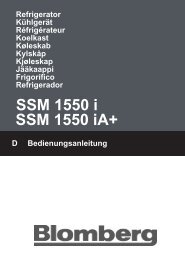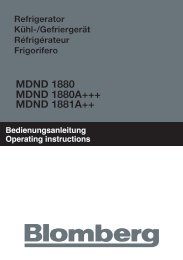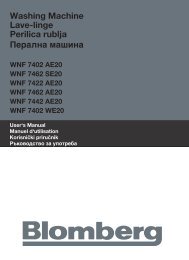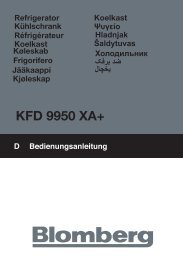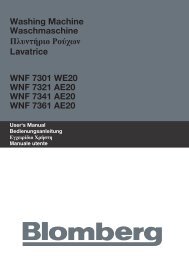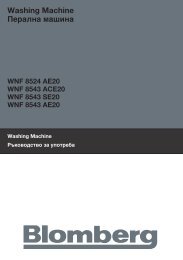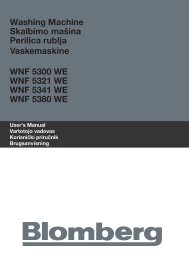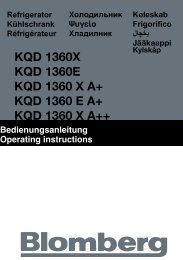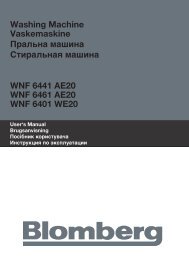3 - Blomberg
3 - Blomberg
3 - Blomberg
Create successful ePaper yourself
Turn your PDF publications into a flip-book with our unique Google optimized e-Paper software.
Things to be done for saving energy<br />
1. Do not keep the doors of your refrigerator open for a long time.<br />
2. Do not put hot food or drinks in your refrigerator.<br />
3. Do not overload your refrigerator so that the air circulation inside of it is not prevented.<br />
4. Do not install your refrigerator under direct sunlight or near heat emitting appliances such<br />
as oven, dishwasher or radiator.<br />
5. Pay attention to keep your food in closed containers.<br />
Changing the illumination lamp<br />
To change the lamp used for illumination of your refrigerator, please call your Authorized<br />
Service.<br />
Should the light fail to work, proceed as follows.<br />
1- Switch off at the socket outlet and pull out the mains plug.<br />
You may find it useful to remove shelves for easy access.<br />
2- Use a flat tipped screwdriver to remove the light diffuser cover.<br />
3- First check that the bulb hasn't worked loose by ensuring it is screwed securely in the<br />
holder. Replace the plug and switch on.<br />
If the bulb works, replace the light cover by inserting the rear lug and pushing up to locate<br />
the front two lugs.<br />
4- If the light still fails to work, switch off at the socket outlet and pull out the mains plug.<br />
Replace the bulb with a new 15 watt (max) screw cap (SES-E17) bulb.<br />
5- Carefully dispose of the burnt-out light bulb immediately.<br />
Replacement light bulb can easily be obtained from a good local electrical or DIY store.<br />
4<br />
Fast-Freeze information<br />
Food must be frozen as rapidly as possible when they are put in a refrigerator in order to<br />
keep them in good quality.<br />
The TSE norm requires (according to certain measurement conditions) the refrigerator to<br />
freeze 4 kg of foodstuff at 32°C ambient temperature to -18°C or lower within 24 hours for<br />
every 100-liters of freezer volume.<br />
It is possible to keep the food for a long time only at -18°C or lower temperatures.<br />
You can keep the freshness of food for many months (at -18°C or lower temperatures<br />
in the deep freeze).<br />
WARNING!<br />
• The foodstuff that you want to freeze must be in good quality.<br />
• Foodstuff must be divided into portions according to the family's daily or meal based<br />
consumption needs.<br />
• Foodstuff must be packaged in an airtight manner to prevent them from drying even<br />
if they are going to be kept for a short time.<br />
Materials necessary for packaging:<br />
• Cold resistant adhesive tape<br />
• Self adhesive label<br />
• Rubber rings<br />
• Pen<br />
Materials to be used for packaging the foodstuff must be tear-proof and resistant to cold,<br />
humidity, odor, oils and acids.<br />
Foodstuff to be frozen should not be allowed to come in contact with the previously frozen<br />
items to prevent their partial thawing.<br />
You can check the freezing capacity of your refrigerator from “Technical Specifications”<br />
section in Part 1.<br />
Always follow the values in the tables for storage periods.<br />
Frozen food must not be used immediately after they are thawed and they should<br />
never be re-frozen.<br />
16 EN




